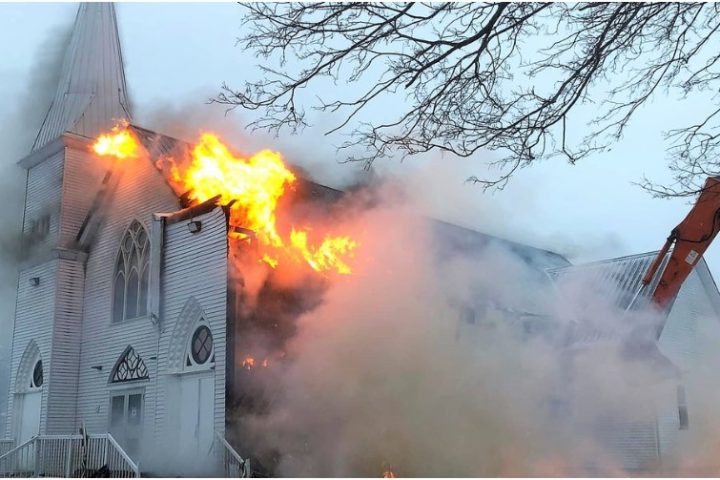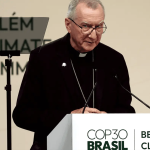When Canada’s Ukrainian bishops sent out their Easter greetings letter this year, they dated it Easter, March 31.
They also dated it Easter, May 5.
The dual dates reflect the two different ways Ukrainians celebrate Easter. Some follow the Gregorian calendar that we do. Others, particularly Eastern and Orthodox Christians, use the Julian calendar.
If you’re confused, you’re not alone. With much time and effort, and the help of my wife who was raised Ukrainian Catholic and Father Deacon Andrew Bennett, a Ukrainian Catholic deacon, I now have a Grade 1 student’s understanding of the situation. Care to join me in the trenches?
Apparently, it all started in 45 B.C., when Julius Caesar ordered a calendar consisting of 12 months based on a solar year. By 1542 the calendar had become increasingly inaccurate, falling 10 days behind where it should have been. In response, Pope Gregory XIII updated it, introducing the Gregorian calendar that was accepted in most Catholic countries. However, Orthodox Christians and Eastern Catholics continued to use the Julian in their religious life for the next several centuries.
Over time, some Orthodox and Eastern Catholics (including immigrants to Canada) adopted the Gregorian calendar in their civil life, while still observing the traditional dates of the old calendar such as Christmas on Jan 7. The result was a hybrid called the “Revised Julian” calendar. The Russian and Ukrainian Orthodox churches and the Ukrainian Greek Catholic Church continued to use the old Julian calendar.

So, even among Ukrainian Catholics in Canada there isn’t a common date for Easter, hence the twin-dated message from their bishops.
As I tried to understand just who celebrates Easter on March 31 and who on May 5, I plunged down an Easter rabbit hole that became even deeper this year thanks to geopolitical developments.
This past December, feast days suddenly got a lot of media attention after the Ukrainian Catholic Church and the Orthodox Church of Ukraine decided to change the days on which some feast days like Christmas are celebrated.
After more than a century of Ukrainian-Canadians celebrating “Ukrainian Christmas” on Jan. 7, suddenly these communities were celebrating on Dec. 25, just like everyone else. The reason? Russia’s invasion of Ukraine in 2022. In an effort to distance itself from everything Russian, Ukraine abandoned the Julian calendar in favour of the Gregorian calendar, and the Ukrainian Greek-Catholic Church and the Ukrainian Orthodox Church followed suit shortly after.
A letter from the Ukrainian Eparchy of Edmonton explained that as the Ukrainian Catholic Church and the Orthodox Church of Ukraine, two of the largest churches in Ukraine, decided to stop using the Julian Calendar, so did many Catholic and Orthodox parishes outside Ukraine.
In Canada, Ukrainian parishes already used a mixture of calendars, but as a result of the latest development, most Ukrainian Catholic churches in North America shifted to the Gregorian calendar in a sign of unity with Ukrainian Catholics in Ukraine. Ukrainian Orthodox living outside of Ukraine made the same decision.
The Eparchy of Edmonton noted the irony that as a type of ecclesial and ecumenical unity develops between Christians in Ukraine and the rest of the world, division is widening between them and the Russian Orthodox Church, which still uses the Julian calendar.
I immediately had questions. If Ukrainian Catholics in Canada celebrated Christmas with the rest of us last Christmas, why are there two dates on the Ukrainian bishops’ Easter letter? Who is celebrating Easter on May 5?
I asked Father Deacon Andrew to walk me through it. It turned out I had no idea what I was about to venture into.
He graciously replied. “Firstly …,” he said.
When an answer starts with “Firstly,” you may want to take a deep breath and reach for another cup of coffee.
It turns out that not only are there two historical calendars – Julian and Gregorian – there are also two liturgical calendars in every apostolic church: Catholic, Orthodox, Lutheran, Anglican …
There’s a calendar of fixed feasts like Christmas, which is always on Dec. 25. Then there is a Paschal or movable Sunday liturgical cycle (Ascension, Pentecost, Sundays of Ordinary Time, etc.) that’s determined by the date of Easter.
Then things get a little more interesting.
“Secondly,” he continued, “the feasts of the fixed cycles vary by church.”
The date on which a particular saint’s feast day is celebrated depends on whether you’re using the Gregorian calendar (which matches the civil calendar) or the Julian. The Latin and Byzantine churches for the last century have followed the Gregorian calendar, while Russia and Ukraine followed the Julian.
“So, while they celebrate Christmas on what to us on the Gregorian calendar is Jan. 7, it’s actually Dec. 25 for them on the Julian calendar. Following me so far?”
At this point, I was starting to wonder if I needed a chart of some sort.
In light of the changes made by the churches in Ukraine, Canada’s Ukrainian Catholic bishops gave Julian-calendar parishes the choice of switching to the Gregorian calendar if they wanted to. Some chose to put it to a parish vote. The result was most Ukrainian Catholic churches in Canada are now following the Gregorian calendar for the cycle of fixed feasts, which if you remember includes Christmas.
I eagerly went on to read Father Deacon Andrew’s next sentence:
“This, however, has nothing to do with the Paschal Cycle and Easter.”
A little part of me may have died at that moment. It turns out a third calendar is involved: the Jewish Lunar Calendar.
Important detail number one: all movable/Paschal holy days in Catholic churches are determined by the date of Easter, the most important of all feast days.
Second important detail: In 1054, a once unified Catholic Church split into East and West. Sadly, one of the casualties of this split was the Paschal calendar.
The Western Latin/Roman church and the Eastern Orthodox churches have different processes for determining the date of Easter for their respective Paschal calendars. In the West, Easter is on the Sunday after the first full moon in spring. In the East, Easter falls on the Sunday after the first full moon in spring that is after the Jewish Passover (which is based on the Jewish lunar calendar).
So when do Canadian Ukrainian Catholics celebrate Easter? I’ll defer to Father Deacon Andrew again:
“In Canada, Ukrainian Greek-Catholic parishes now following the Western reckoning will have already celebrated Easter. BUT, there are still a good number of our Ukrainian Greek-Catholic parishes in Canada that follow the Eastern reckoning which have not celebrated Easter.”
Passover happens to be super late this year, so Easter for almost all of Orthodox, Byzantine, Coptic, Armenian churches falls on May 5, after Passover.
In summary, Ukrainian Greek Catholics in Canada are divided about when to celebrate Easter. It’s roughly the same in the U.S. As for Ukraine, the three Orthodox churches including the Ukrainian Greek Catholics will all celebrate on May 5.
As for the future, Father Deacon Andrew holds out hope that one day we may all celebrate on the same day, and next year looks particularly promising. In 2025, the two means of determining Easter actually line up, and both Paschal calendars have Easter on April 20 in 2025.
It’s also notable, he said, that next year is the 1,700th anniversary of the first Ecumenical Council at Nicaea, a council at which one of the principal goals was to determine a common celebration of Easter.
“Please God we can all agree on that FINALLY next year, and have one common celebration until the Lord’s return,” he said.
If not for unity’s sake, then at least for sanity’s.






